Consumer groups, including the World Vapers Alliance (WVA), called for the inclusion of harm reduction strategies in global tobacco control policies, citing real-world evidence.
In a report marking the 20th anniversary of the World Health Organization’s Framework Convention on Tobacco Control (WHO-FCTC), the WVA said involving civil society and consumers would lead to more effective, evidence-based strategies to reduce smoking-related harms and improve public health outcomes.
“Their involvement can lead to more effective, evidence-based strategies to reduce smoking-related harms and improve public health outcomes,” the WVA said in its report, “Rethinking Tobacco Control: 20 Harm-Reduction Lessons the FCTC Should Take Note Of.”
The report urged the WHO-FCTC to include harm-reduction experts and consumers in discussions, arguing this would help smokers globally, and to respect adult choices.
“Smokers and ex-smokers want to be treated as capable adults making informed decisions, not as subjects of a paternalistic nanny state. Policies that respect individual autonomy while providing accurate information are more likely to succeed,” the report said.

The WVA report criticized what it called the WHO-FCTC’s “outdated and dogmatic approach,” citing Australia’s experience with strict vaping regulations, which it said had led to a thriving black market and continued high smoking rates. “Embracing harm-reduction is more effective than bans,” it said.
Consumer advocacy group Consumer Choice Philippines echoed this, saying new technologies offered smokers better alternatives to cigarettes.
“Consumers should be heard, and the WHO-FCTC should respect their rights to have access to smoke-free products that lessen their exposure to harmful substances. Nicotine is not the problem, but it is the smoke from tobacco products that contain toxicants,” said Consumer Choice Philippines chairman Adolph Ilas.
The WVA report highlighted the success of harm reduction in Sweden, where the use of snus, nicotine pouches, and vaping had contributed to a smoking prevalence of 5.6%, lower than the EU average of 24%.
The group urged policymakers to consider the full spectrum of harm-reduction tools, including flavored vaping products and nicotine pouches, to help smokers quit.
“By doing so, we can accelerate the decline in smoking rates and significantly reduce the burden of smoking-related diseases on our healthcare systems and society as a whole,” the report said.
The WVA also cited potential economic benefits of harm-reduction strategies, including lower healthcare costs and reduced productivity loss.
The report pointed to the potential of alternative nicotine products to reduce the health burden of smoking, particularly in low- and middle-income countries, noting former smokers who switched to harm-reduction products reported improved quality of life.
The report said harm-reduction products eliminated secondhand smoke concerns, adding human biomarker studies demonstrated the harm-reduction potential of tobacco-free nicotine pouches.
“Even partial switching to less harmful alternatives can be a step toward complete smoking cessation. This gradual approach can be less daunting for some smokers,” the WVA said.
“As we look toward the next decade of tobacco control, it’s time for the FCTC to learn from these experiences and incorporate harm reduction more fully into its framework. By doing so, we can accelerate progress toward a smoke-free future and save millions of lives,” the report said.



















